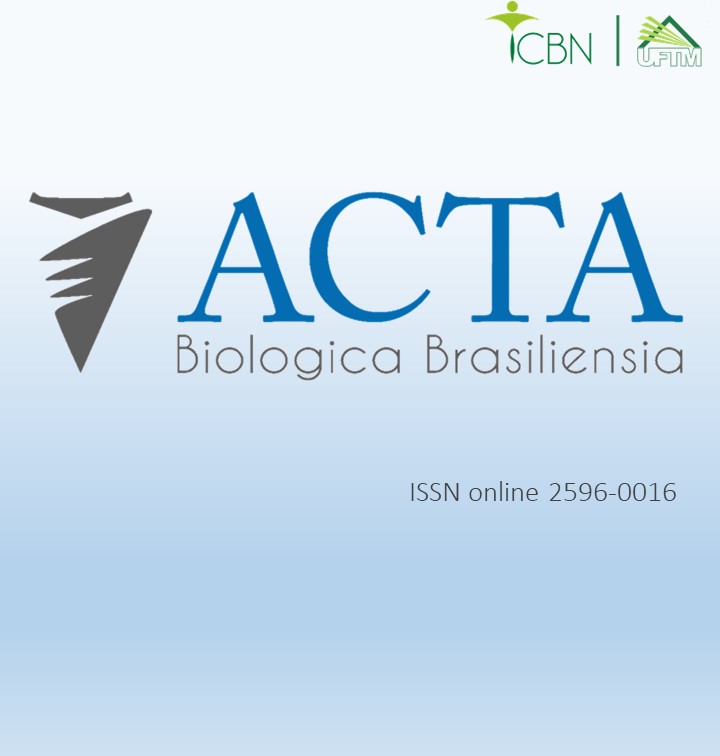CARACTERIZAÇÃO DOS AGENTES POLINIZADORES BIÓTICOS E ABIÓTICOS E SUA ATUAÇÃO NA MANUTENÇÃO DA VARIABILIDADE, ADAPTABILIDADE E DIVERSIDADE DE ESPÉCIES FLORÍSTICAS
DOI:
https://doi.org/10.18554/acbiobras.v7i1.7646Palavras-chave:
adaptação, angiospermas, ensino-aprendizagem, polinizaçãoResumo
A mutualidade entre a flora e a fauna é vista desde estudos de Gregor Mendel e Charles Darwin, em que as interações para benefícios mútuos mantinham a vida em existência. A polinização constitui um processo essencial para a perpetuação de inúmeras espécies vegetais, podendo ocorrer de duas formas: autopolinização, quando ocorre a transferência do pólen da antera para o estigma de uma mesma flor ou de outra flor da mesma planta; e cruzada, quando o pólen de uma flor é transferido para o estigma de outra flor de uma planta diferente. A adaptabilidade das espécies com o processo de polinização permitiu que a variabilidade se estendesse devido aos agentes polinizadores, e claro, aqueles que vão além das abelhas, sendo agentes bióticos (animais), levando em consideração todos os tipos de insetos e até mamíferos, como o morcego; e agentes abióticos, como a água e o vento. Com o objetivo de identificar e classificar os diversos agentes polinizadores, mantendo a mesma importância entre eles, usou-se de estudos científicos disponibilizados na íntegra, a fim de promover o ensino-aprendizagem e a conscientização da preservação da diversidade e variabilidade floral, e consequentemente, a faunística, por intermédio dos processos de polinização. Foi possível identificar a intensificação da existência das espécies de Angiospermas, bem como suas adaptações para o processo de polinização, como por exemplo: formato de flores, cores, texturas e aromas, sendo os agentes polinizadores (bióticos e abióticos) a principal fonte de garantia da variabilidade genética das espécies, atuando na preservação e na manutenção da diversidade floral.
Referências
Barônio GJ, Maciel AA, Oliveira AC, Kobal ROAC, Meireles DAL, Brito VLG, Rech AR. Plantas, polinizadores e algumas articulações da biologia da polinização com a teoria ecológica. Rodriguésia [online]. 2016; 67(2): 275-293. https://doi.org/10.1590/2175-7860201667201.
Rech AR, Agostini K, Oliveira PE, Machado IC. Biologia da polinização. In: Rech AR, Westerkamp C. Biologia da polinização: uma síntese histórica [capítulo 1]. Rio de Janeiro: Projeto Cultural. 2014; 29-45.
Nascimento WM, Gomes EML, Batista EA, Freitas RA. Utilização de agentes polinizadores na produção de sementes de cenoura e pimenta doce em cultivo protegido. Horticultura Brasileira. 2012; 30(3): 494-498. https://www.scielo.br/j/hb/a/XtRcpwtcnJ4b37WxVYYyN9x/?lang=pt&format=pdf.
Firetti-Leggieri F, El Ottra J. Polinização e tipos de reprodução em angiospermas [capítulo 2]. Botânica no Inverno, São Paulo: Instituto de Biociências da Universidade de São Paulo. 2013; 103-108.
Gonçalves C, Passala J, Santos JC, Vieira CMGC, Júnior NZ. Conscientização ambiental no âmbito escolar: a importância da polinização e o declínio dos Agentes polinizadores pelo uso excessivo de inseticidas. BJD (Brazilian Journal of Development), Curitiba. 2021; 7(6): 58358-58375. https://ojs.brazilianjournals.com.br/ojs/index.php/BRJD/article/view/31298/pdf.
Marcos Filho J. 2005. Fisiologia de sementes de plantas cultivadas. Piracicaba: FEALQ, 495p.
Freitas BM. 2006. Polinizadores e polinização: o valor econômico da conservação. Disponível em: http://www.reacao.com.br/programa_sbpc57ra/sbpccontrole/textos/brenofreitas.htm.
Oliveira PE, Maruyama PK. Sistemas Reprodutivos. In: Rech AR, Agostini K, Oliveira PE, Machado IC. Biologia da Polinização. Rio de Janeiro: Projeto Cultural. 2014; 71-92.
Neto HFP, Oliveira PE. As anonáceas e os besouros. Ciência Hoje. 2006; 38 (224): 69-61. https://www.academia.edu/9406279/As_anon%C3%A1ceas_e_os_besouros.
Pereira MC, Nietsche S, Costa MR, Crane JH, Gorsato CDA, Mizobutsi EH. Anonáceas: pinha, atemoia e graviola. Informe Agropecuário. 2011; 32(264). https://www.researchgate.net/publication/274699663_Anonaceas_Pinha_Atemoia_e_Graviola#:~:text=Abstract,devem%20ser%20propagadas%20por%20enxertia.
Brunelli WA. Ornitofilia nos Neotrópicos e nos Paleotrópicos. 2013.
Fischer E, Araújo AC, Gonçalves F. Polinização por vertebrados. In: Rech AR, Agostini K, Oliveira PE, Machado IC. Biologia da Polinização. Rio de Janeiro: Projeto Cultural. 2014; 311-326.
Varassin IG, Amaral-Neto LP. Atrativos. In: Rech AR, Agostini K, Oliveira PE, Machado IC. Biologia da Polinização. Rio de Janeiro: Projeto Cultura. 2014; 151-168.
Carvalho R, Machado IC. Rodriguezia bahiensis Rchb. f.: biologia floral, polinizadores e primeiro registro de polinização por moscas Acroceridae em Orchidaceae. Brazilian Journal of Botany. 2006; 29(3): 461-470. https://www.scielo.br/j/rbb/a/qK4hBJPBVSLtBYPTzwL5cPL/?lang=pt.
Oliveira R, Júnior JAD, Rech AR, Júnior RSÁ. Polinização por lepidopteros. In: Rech AR, Agostini K, Oliveira PE, Machado IC. Biologia da Polinização. Rio de Janeiro: Projeto Cultural. 2014; 235-257.
Janzen DH. Coleção Temas de Biologia, Ecologia Vegetal nos Trópicos. Editora da Universidade de São Paulo. São Paulo: SP, 1977, 74p.
Raven PH. Evert RF, Eichhorn SF. Biologia Vegetal, 6ª ed., Rio de Janeiro: RJ, Guanabara Koogan, 2001, 906p.
Souza DL, Evangelista-Rodrigues A, Pinto MSC. As abelhas como agentes polinizadores. REDVET. Revista Electrónica de Veterinaria. 2007; 8(3): 1-7. https://www.redalyc.org/pdf/636/63613302010.pdf.
Barbosa DB, Crupinski EF, Silveira RN, Limberger DCH. As abelhas e seu serviço ecossistêmico de polinização. Revista Eletrônica Científica da UERGS. 2017; 3(4), 694-703.file:///C:/Users/usuario/Downloads/As_abelhas_e_seu_servico_ecossistemico_de_poliniza.pdf.






